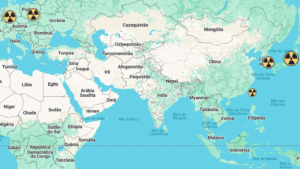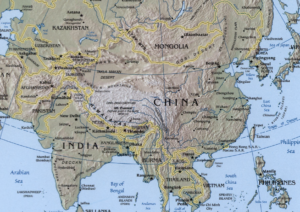- At the end of 2022, the United States released its new National Security Strategy;
- The document sees China and Russia as the US’s main strategic competitors;
- Washington intends to use its system of alliances and economic nationalism as a strategic weapon against Beijing and Moscow.
Published in October 2022, on the official website of the White House, the new National Security Strategy of the United States is a 50-page document that facilitates understanding of what the current government of the country thinks about the current geopolitical scenario, bringing an American perspective on what is happening in the world.
The document is important, as in addition to governing the national security strategy, it will also dictate the economic and political strategies of the United States for years to come – or at least as long as Joe Biden and the Democrats remain in power. In addition, it brings many important changes to the geopolitics of the country and the world as a whole.

What is the US National Security Strategy and what is its purpose
The National Security Strategy of the United States is a document published periodically, on average every four years, with the aim of listing the concerns of the current government, which is prepared by the executive branch.
The 2022 document is objective about what the United States thinks about what is happening in the world today, without subjective phrases or messages that can be interpreted in various or erroneous ways, citing countries and the desires of the current government.
The introduction is made by President Joe Biden, who mentions the current geopolitical competition, the interests of the United States and the challenges to achieve these goals. In short, it is a great summary of what the document will address, in addition to Biden’s view of the world and the points covered in the National Security Strategy.
To understand the document, it is possible to divide the points addressed into six main ones:
- General Approach: At the beginning, the document cites the intentions of the United States to remain engaged in geopolitical leadership. Despite this, the country declares that it has no intention of leading by itself, but leading those who have an interest in cooperating with the country and similar values.
Here, a strategic competition is mentioned, highlighting how it will shape the new world order, in addition to reinforcing the country’s intentions to create a “free, prosperous, open and secure” world through global alliances, mainly with the European Union and countries of the Indo Pacific, which would directly affect Russia and China respectively, although this influence is not mentioned in the document.
- Strategic challenges for what’s to come: Again being commented, the document reaffirms that strategic competition will increasingly shape the world order with countries fighting for their economic sovereignty, as the post-Cold War era is over and the decade we are in will be decisive for how the world will move forward.
The aforementioned strategic challenges are two:
- America’s desire to lead and the competition to do so.
- The fact that the world still needs to fight together against terrorism, hunger, disease, climate changes, inflation and pandemics.
That is, despite the United States’ desire for leadership, the country still needs to collaborate with other governments.
- Position of the United States of America on the world stage: The role that the country plays on a broader world stage is also a highlight of the document, which emphasizes the willingness to cooperate with those countries that share the same values, almost as a message to nations such as New Zealand, Australia, India, Japan, South Korea and Canada.
So, from the moment these alliances are formed, the need to understand that the rest of the countries are economic competitors is emphasized, but to understand that these competitions do not need to turn into conflicts.
- Overview of the United States: In pursuit of this world that is “free (with human rights and individual freedoms respected), open (with all countries building the rules), prosperous (with rising standards of living around the world), and secure (without aggression and intimidation)”, the document also informs the country’s desire to focus on three objectives to pursue this:
- Power and influence
- Political alliances
- Modernization and strengthening of military power
- Pillars of thought: Here are highlighted the main points of thought that govern the entire new National Security Strategy, such as increasing local trade, even if exports continue. Creation and strengthening of alliances with partners around the world, seeking at least one partner in each continent that shares the same values as the United States.
They also highlight China as one of their biggest geopolitical competitors, even though Iran is also a challenge, it does not reach the level of China and Russia is not given as much importance for its recklessness, considering the conflict with Ukraine.
In addition, this topic emphasizes the focus on Latin America and the Middle East, mainly on the Gulf region due to its oil concentration.
- Global Priorities: Finally, the document highlights US priorities, such as beating China on economic issues and preventing it from reshaping the world political landscape, while collaborating on climate, health and certain economic issues.
With regard to Russia, the document reinforces the intentions of the United States to continue supporting Ukraine and to do everything possible to prevent a nuclear escalation.
Last but not least, the country also stresses its desire to define the future of technology, cyber commerce and the economy as a whole.
What are the geopolitical consequences of the new American National Security Strategy? Why is it important?
Analyzing the six main points declared in the New National Security Strategy, it is noticeable that the United States considers China and Russia as the main competing countries, focusing on the fact that both did not accept the post-Cold War period and want new molds for the world.
In the case of China, the document focuses a lot on economic competition, but bringing an analysis to political issues, it is possible to consider, after some highlights of the document, that in a possible attack on Taiwan by China to change the status quo, the United States would provide military support to the island.
In this way, the Chinese Republic can rethink before considering attacks or advances like Russia’s in Ukraine.
Regarding Russia, the document makes clear the country’s recklessness, defending Ukraine and reinforcing that the United States will continue against the invasions carried out in the country and support it militarily.
In addition, based on the main points highlighted, it is also possible to consider the strengthening of NATO, a military alliance that includes the participation of several countries located in the northern hemisphere, in addition to the creation of treaties and strengthening of relations with the European Union.
In addition, with this document the United States also demonstrates its intention to strengthen the Quad partnership, a forum in which the country meets with Japan, India and Australia for discussions. This could already be observed even before the new Security Strategy was published, when Biden met with the leaders of member countries in 2021.
It is important to note that the Quad countries are located in the Indo Pacific and, with the United States strengthening these ties, the “veiled” objective of containing China in this region is clear.
With so much emphasis on the ideas of security, freedom, openness and prosperity, it is possible to state that the United States will not carry out, in the short term, invasions in other countries as it did with Iraq in 2003, claiming to bring democracy, because economically, militarily and politically speaking, carrying out these acts has a high financial, image and influence cost for Washington. Therefore, the country can eventually ally with autocracies when necessary, as with countries in the Middle East.
Terrorism, which was a recurrent subject in previous national strategies, did not gain as much focus in the 2022 document.
Finally, the United States can bet on economic nationalism, encouraging its companies, mainly in the field of technology with microchips, to compete economically with China, through economic protectionism that will be beneficial for the United States, but not for its competitor, China, which could end up weakened economically.










[…] development, China could become a more attractive partner for Middle Eastern countries than the United States, which has long been seen as an unreliable partner due to its frequent intervention in regional […]
[…] production hub de-risking China: with the proximity between Mexico and the United States, the North American country may prefer to concentrate its exports and imports through Mexican […]